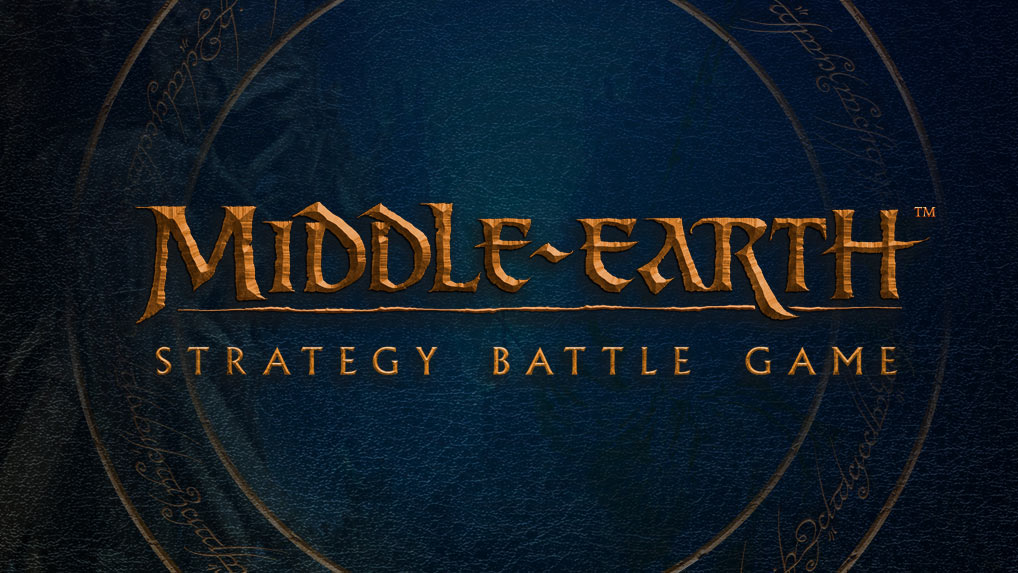This week we’re kicking off some semi-regular coverage of Games Workshop’s Middle Earth Strategy Battle game, starting this week with an article around how to get started with the game and continuing next week as we look at tactics and strategy. Whether you’re a veteran of the game or someone who’s seen the models but never started and is interested to know more, we’ll have something for you in this series. So please join us on this journey through the miniature battlefields of Middle Earth.
A Short History of the Lord of the Rings game
At the end of the last century, Games Workshop was looking to licence an intellectual property for a new game, having previously licenced Star Trek, Doctor Who, Judge Dredd and Lord of the Rings in the 1980s. GW were looking at several potential properties, and went so far as to produce mock up figures for some science fiction films made in the late 70s and early 80s after the licence West End Games had for that IP lapsed.
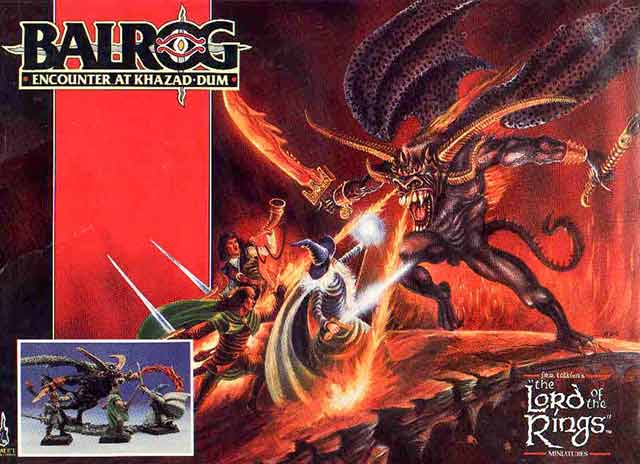
There was an announcement that Peter Jackson, famed director of Bad Taste and Meet the Feebles, was going to make a live action version of Ralph Bakshi’s Lord of the Rings films, which themselves were originally based on a series of books by English academic and PTSD suffering war veteran John Tolkien. In turn these books were based on Wagner’s Ring cycle and European folklore.
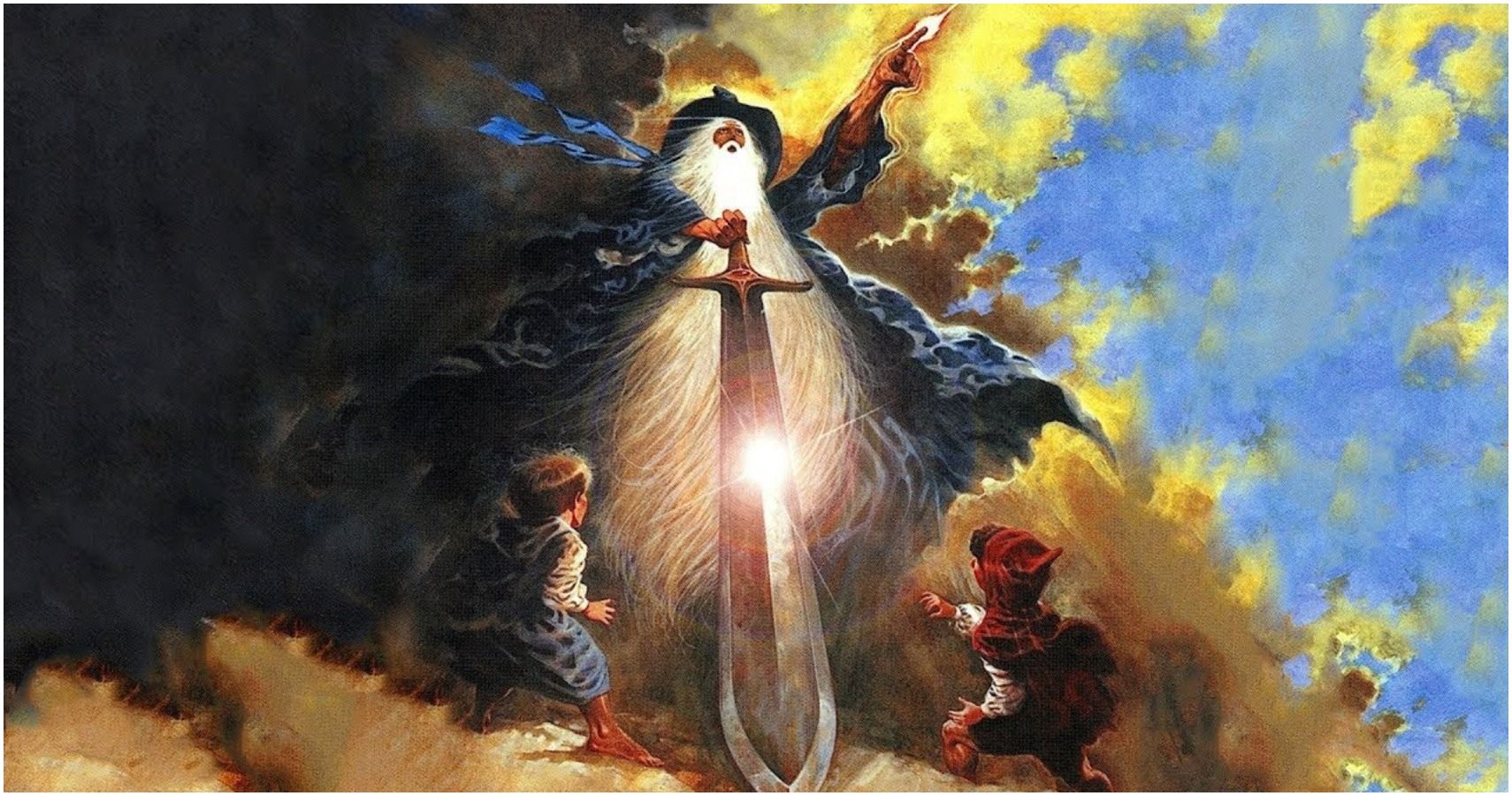
This was to be a trilogy of films starring Christopher Lee, a rock musician and former special forces Nazi hunter, Liv Tyler, daughter of Rolling Stones fan Steve Tyler, a number of former child actors, and gay rights activist Ian McKellan.
Jackson’s new Lord of the Rings films was raised as a possible intellectual property for GW to licence, and a skirmish wargame set in Middle Earth was pitched to the CEO, Tom Kirby, by Rick Priestley, author of Warhammer 40,000: Rogue Trader (otherwise known as Warty-K). Rick’s pitch included the phrase ‘we can’t afford not to’ as he believed that Lord of the Rings had mass market appeal.
This led to the creation of a dedicated team including the Perry twins, who sculpted the initial miniature releases. The Perry twins, along with Alessio Cavatore and Brian Nelson, appeared in the Return of the King film. They also created possibly GW’s best game.
The first edition of the game was launched in 2001, and due to releasing shortly before the cinematic film did not include images of some of the models to avoid spoilers. As the Lord of the Rings films were released each year from 2001 to 2003 (having been shot in 1999-2000) new editions of the game were released each year, with new plastic kits and revisions to the rules set. Following this there was a consolidated edition, and further edition with the Mines of Moria plastic starter set (which included a plastic fellowship and cave troll), another edition for the Hobbit film and finally the current, 7th edition, which released with the Battle of Pelennor Fields box.

A large number of new hobbyists started collecting, painting and gaming with either the boxed sets produced around the films release, or the DeAgostini part work series (which ran from 2002-2006), which was the best selling partwork in DeAgostini’s history.
With the demise of GW’s official forum in 2006, the Lord of the Rings game fans moved to a number of smaller websites specifically for Lord of the Rings, such as The Last Alliance (now gone), The One Ring, etc. This split has largely remained in place during the migration from specialist forums to Facebook, and Lord of the Rings players tend to have their own events and hobby ecosystem that does not interact with the wider 40k fandom. As a result the online community is smaller, but more welcoming and without some of the less savoury elements of the fandom. For instance for UK events they are tracked here.
This leads to a similar phenomenon as seen with narrative and specialist game players, where 40k players assume these are dead games because they don’t see people talking about them in 40k groups, when they simply have their own place online to go and their own events. We can all remember people saying Titanicus was a dead game at the same time that Reaver Titans sold out three times and had to be reprinted.
There are pockets of ME:SBG players across the world, with some countries seeing large events (Australia has a large tournament scene and produces a lot of content around it on YouTube for example) and a vibrant community. Searching Facebook for ME:SBG plus your country, or other key word searches should hook you into the community where you are. If you can’t find events, just ask in the facebook group as to whether there are events running in your country, and what format they use.
Games Workshop’s relaunch of Middle Earth: Strategy Battle Game has limited new sculpts in plastic, but has seen a number of new resin models from Forgeworld, including an entirely resin army in the Iron Hills Dwarves. The new plastics are a large step up from the older plastics as they are created with modern sculpting technology, and have mainly focused on characters (with Rohan benefiting from Theoden, Eomer and Durnhelm in plastic).
The game has seen no substantial changes to the core rules engine across the seven editions, because at it’s core it is simple to learn and play, but has the potential for great depth.
Why you should play Middle Earth Strategy Battle Game
Do you like small, relatively balanced skirmish games in a fantasy setting? Do you like Lord of the Rings? Do you want to paint Warhammer, but smaller? Do you like a smaller but friendlier community that’s less crunchy and meta chasing? Do you like painting less miniatures than 40k? Do you like fantasy but more classic fantasy? Are you a fan of three hour + long movies that you can put on while painting your tiny people?
These are all good reasons to play.
The miniatures, though many of them are from the turn of the century, are generally good. Many were originally metal miniatures, with a number of rank and file troops available as single frame infantry. There was another wave of releases to accompany the Hobbit films, but the LOTR bubble had burst by this point and a combination of reduced enthusiasm for the films and very high prices on the hobbit range when it launched contributed to a lack of sales. The new starter set, Goblin Town, was not a success, and the initial run of starters with an exclusive additional miniature, Radaghast, did not sell out during the entire release period of the movies.
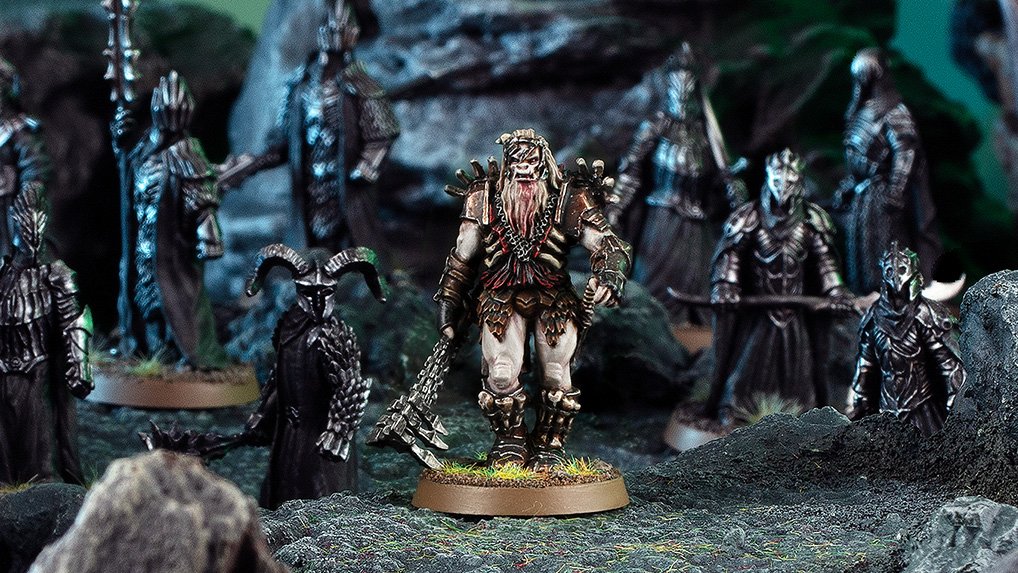
It is likely that a significant number of releases were cancelled due to this poor performance, such as releases for the Iron Hills dwarves, which would eventually come out as resin miniatures. The initial Hobbit release wave in 2012 did have a fairly decent number of good plastics, including Hunter Orcs on foot and on Warg, but the prices were high at the time and this didn’t help sales.
This influx of modern plastics and additional sculpts boosted the range, but it was not completed and while the sixth edition of the rules was another evolution the game stayed fairly stagnant until being rebooted into seventh edition in 2018 with the release of Battle of Pelennor Fields, which saw a new rulebook bundled with a giant pile of miniatures, including the first new plastic kit in a while, Theoden, King of Rohan.
Ludonarrative Dissonance
Ludonarrative dissonance is where a games mechanics and the way that it is played contradict the lore and plot of the game. Like how super elite Space Marines got shovelled off the table in big piles before GW gave them all two wounds, or how Last of Us II is about people who think they’re good people but has puppy stabbing mechanics.
It’s where the gameplay itself goes against the stated purpose and story of the game. Kill team was meant to be a quick-playing skirmish version of 40k, but takes longer to play and is more complex than Combat Patrol, the 500-point variant of Warhammer 40k. Thus it suffers from ludonarrative dissonance.
The term was popularised in video game discussion (the example you’re most likely to find it associated with is the original Uncharted from Naughty Dog), but is worth bearing in mind when looking at games design.
What Lord of the Rings doesn’t suffer from is ludonarrative dissonance. The way heroes work in the game makes them heroic. The use of might for modifying dice rolls and calling heroic actions makes them epic and game changing, but feels right in the hands of heroes.
Force selection in the new edition is similarly effective, giving you a hero and retinue, reflecting the background in terms of how forces were organised in medieval/dark ages warfare. It ensures a reasonable number of heroes and thus that there are heroes there to do heroic things.
The latest iteration of the game is the best version.
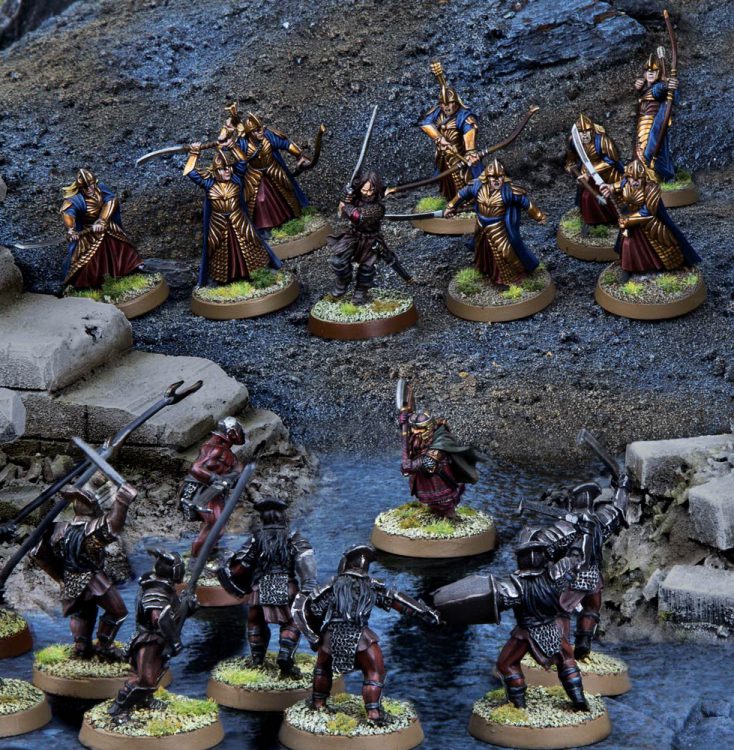
Starting Middle Earth Strategy Battle Game
If you want to start the game you need to work out two things. Do you want to buy the starter set (which is jammed with miniatures) or not, and do you want to play Lord of the Rings era or Hobbit era?
Your first purchase should include a rulebook, and the Pelennor fields box has that along with the start of 3 different armies, but it does bias you towards Lord of the Rings. The next purchase should be the army book for the era you want, either LOTR or the Hobbit.
If you want to be a super serious tournament player or a casual narrative player the set is solid either way, because Rohan are a tournament favourite and there are so many minis in there for a casual player to dig into.
If you are set on playing just the Hobbit era however, say Iron Hills dwarves or Azogs legion, then it is of limited use and getting a separate rulebook and the Armies of the Hobbit may be the best bet.
Should you collect a good and an evil army? Yes, would be my advice, as it means you can provide both sides in club play or at home, and if there are Good vs Evil events running that you want to go to you are covered either way.
For club play you may want to look at Battle Companies as a way of starting, where you’ll collect a small force and add to it. Running Battle Companies at your local club is a good way to end up with a crop of players to play bigger games against later, and the difference between what you need for Battle Companies games and 4-500 point games is not a big one.
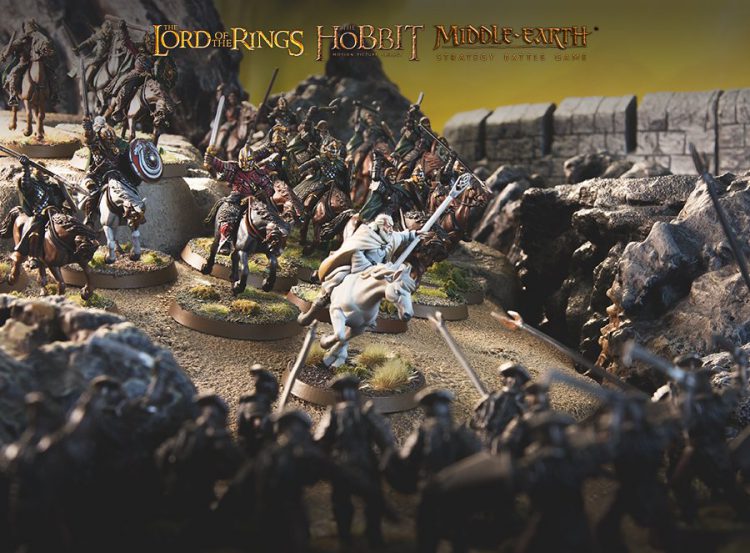
Choosing an army
Are you a super serious competitive player, or a more casual gamer? Either way just pick the faction you want to play. If you’re super serious you can fiddle and optimise, but pretty much every army has viable builds for competitive play, and those are generally themed forces with Legendary Legion rules.
If you’re an evil player you’ll have to accept that orcs are chaff and will die in large numbers, but are useful as cheap speed bumps to pin the enemy in place while your heroes, monsters, elites and stuff that doesn’t suck pick fights they can win, or a good cheap objective holders and archers. For evil you are very much about your heroes and monsters unless you are playing something like Uruk Hai or Easterlings where you have high performing rank and file troops.
If you’re a good player then depending on your faction you will have different expectations for your troops. If you are Elves or Dwarves then expecting your troops to win fights and murder things is realistic. Men tend to be a bit more squishy, and Hobbits sit at the bottom of the pile, getting murked by all and sundry (though they make up for it with huge piles of characters).
In your army selection look at what you need, and in LOTR you need three things:
- Movement – you need to get across the board, onto objectives, and into combat. This makes having some cavalry very useful, and even armies with murderous infantry (Dead of Dunharrow, Dwarves) really benefit from some higher movement troops, while Rohan or cavalry based armies can dominate in the movement phase. Some armies have special rules that give bonuses to movement (Uruk Hai scouts with legendary legion rules getting bumped to 8” movement for example). Drums can help Evil players get this done, and are worth looking at in higher point games.
- Might – You need heroic actions and for this you need might points, and you then need might to win key fights and punch through enemy lines. You have to take some characters, so take a look at what they give you. Named characters often have additional bonuses worth the extra points they cost. At low points cost games look at the named character versions of captains (characters 75 points and below) and see if they are worth it vs standard captains.
- Murder – how are you going to make your opponent’s models dead? Evil armies have monsters and characters to use, Good rely a little more on their rank and file. This tends to lead to Good armies composed of human sized models and cavalry, while Evil love some monsters to squish things (trolls for example). Good armies tend to have access to some sort of elite troops (Grim Hammers, Khazad Guard, Palace Guard, Royal Guard, Citadel Guard, etc) with Fight 5 or the ability to be treated as Fight 5 if certain criteria are met, while Evil have more chaff (but a chaff orc with a bow or spear is still pretty useful). Evil players looking at cool monsters should have zero regrets, especially if they can get hero monsters like Buhrdur.
When picking your army you may focus on one or two of these (Dwarves aren’t great on movement, but have solid heroes and blender through things like Orcs) but cannot always have all three. All cavalry armies are tempting (Theoden’s Royal Guard or Elronds knight gang for example) but have a low model count and break quickly if they take casualties. If a key charge fails they can be swamped and pulled down, and shooting or stabbing horses means some very expensive models can end up walking. But they dominate in getting across the board, and can often pick their fights due to higher movement.
You can select a force of anything, but this means not getting access to the army special rule. You can select a historically viable force, and gain an army special rule. You can also select a legendary legion from one of the supplements, which has more restrictions but more special rules, for example the pure Dunlending force from the War in Rohan book, or the Army of Gothmog from the War in Gondor book.
These supplements add some more models (fairly often the new releases for the game from Forgeworld) and different army builds with associated special rules. Want to be hated by your friends? You can combine Rohan and Woses for fast cavalry plus blowpipes in Paths of the Druadan.
This means it’s a series of trade offs. Some abilities will be gated behind certain models (Thorin, Theoden, Mauhur or Aragorn for example) in some legendary legions. All the legendary legions reflect a key idea and conflict they fought in, and are great for creating a themed force. Some models can be used in multiple legendary legions (Riders of Rohan can be included in five different legendary legions at least) and different army themes (the humble orc can be used in Angmar, Barad-Dur, Mordor, Isenguard, etc). This makes things like a box of Orcs a solid purchase for evil players. The Morannon Orcs in the Pellenor set are a Mordor specific Orc, but can be included in a Gothmogs Legion and The Black Gate Opens Legendary lists.
How big an army should I collect?
You can collect an army as large as you like, but you should aim for a minimum of 400 points. 500, 600 and 750 points seem to be the more common levels for competitive play. At 400 any heroes you have will be minor ones, and you might be packing one monster as the evil player. At 500 you’ll be including a bit more and could be throwing in a big character. At 600 and 750 you can start taking a decent amount of toys.
For a lot of armies a couple of plastic boxes and a few blisters will easily take you to 6 or 700 points, as the system is fairly cheap to get into (a command blister and a box of basic troops is almost always a good buy).
Some legendary legions peak at certain power levels. I feel Ugluk’s Scouts and Wolves of Isengard do well around the 500 point level, but when you are playing at 750 you feel the lack of access to monsters or powerful characters. Similarly legions like Gothmogs Legion or The Riders of Theoden benefit from 750 point games because they want to take a lot of pricey characters or other toys.
If you are a competitive player look at the events you want to go to and the point levels that they play at. If you have multiple list styles/legendary legions available to you (like Rohan or Isengard) then if you put a little thought into what you are collecting a larger collection can be flexed to different lists. A Rohan player would definitely want the Theoden and Gamling, and these models, coming to over 200 points on their own, can be included in several different legendary legions.
If you don’t want to do events, then you can’t go wrong buying the models you want to buy because you like them, though you could end up going some fairly out there themed lists (Ents or Eagles or Trolls being an example).
Final Thoughts
Middle Earth Strategy Battle Game is one of the best GW games, with a fleshed out miniature range and a background with a lot of fans and enthusiasts. It has welcoming online communities and an events scene across the world. It’s cheaper to get into than 40k or AoS, and is essentially a finished game (I doubt there’ll be any major releases beyond little FW extras or plastic characters unless GW do something with the Amazon series). The game is well balanced, and easy to learn.
Sounds like you should be playing it.
Have any questions or feedback? Drop us a note in the comments below or email us at contact@goonhammer.com.
